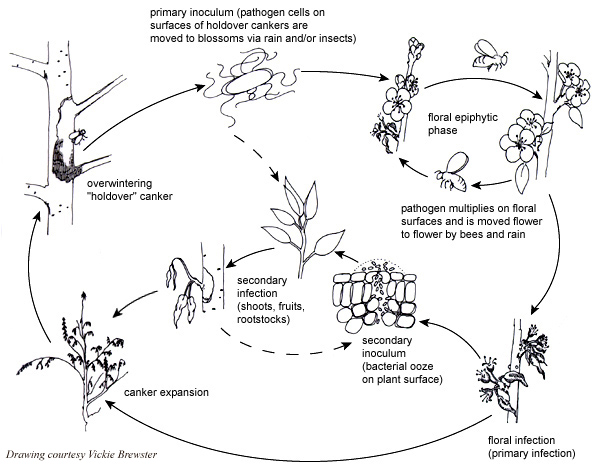By Scott Ockey
As many growers know and some have unfortunately experienced, fire blight can destroy an entire orchard in a single growing season. Even if you catch it early on, it can still cause significant damage to blossoms, fruit, shoots, branches, scaffolds and entire trees. Throughout the years, growers have turned to pruning and a variety of traditional chemical-based products, which may cause the fire blight bacteria to become resistant, and the treatments lose efficacy.
Since fire blight often spreads faster than growers can control it, you need to be aware of how the disease forms, along with its signs and symptoms to prevent the disease from rapidly spreading throughout your orchard.
Fire Blight Disease Formation
Fire blight disease, caused by the bacterium Erwinia amylovora, typically appears in the early spring in apple and pear orchards when temperatures rise above 65° F and rain, heavy dews, and/or high humidity are present. Due to variable conditions, the disease may be more common in some years. For example, fire blight occurrence was lower than average in 2021, but disease pressure is likely to increase in 2022 due to forecasted weather conditions.
Crops most susceptible to fire blight:
- Apple
- Pear
- Quince
- Crabapple
- Blackberry, Raspberry
- And more depending upon region and climate
Recognizing and managing fire blight infections early is imperative to reducing the spread of disease, so growers typically use the Cougar Blight Model and the Maryblyt Model to assess the risk of trees based on climate conditions.
Once Erwinia amylovora begins growing, it quickly colonizes plant surfaces and can move to other trees by pollinating insects or rain. As it grows, it forms bacterial ooze to protect the pathogens on the plant surface, enabling it to spread even more rapidly.
Here’s How:
- Fire blight can overwinter as cankers in living tissue on the trunk and branches or even in mummified fruit. These cankers can then become active and produce bacteria in the spring, causing damage year after year in certain trees, and a single canker may produce millions of bacteria, enough to infect an entire orchard.
- Infections usually initiate during bloom when cankers open and bacteria are carried to flowers by rain, pollinating insects or other practices like improper pruning, causing blossom, shoot and spur blight.
- Then, bacteria multiply rapidly on the blossom stigmatic surface (due to its nutrient density), enter the blossom via the floral cup and spread to shoots hat have openblossoms, which can result in more infection in different parts of a tree and throughout the orchard.
Source: APS, "Fire Blight of Apple and Pear"
Symptoms and Signs of Fire Blight
As trees break dormancy in the spring, growers may start seeing the first signs of fire blight by noticing oozing cankers (sunken purple or black discoloration of the bark) . During late bloom to early fruit set, infected blossoms will have watersoaked tissue with off-white to amber ooze. Blossoms will then turn brown and wilt, shoots will exhibit a typical shepherds crook symptomand leaves will shrivel. Often leaves on infected shoots do not abscise and will remain through dormancy unless pruned.
The name is fitting, because it makes the trees look as though they’ve been set on fire and burned. The devastation can be massive in a short amount of time, causing widespread damage in just 1-2 weeks.
Look for these signs in apple and pear trees:
- Blossoms become water soaked, wilt and turn brown or black.
- Shoot infections may become worse through wounds formed by sucking insects such as aphids or leafhoppers or weather conditions such as frost, high winds, rain, or hail.
- Blighted twigs first appear water-soaked, then turn dark brown or black. Twigs will then bend to form an upside-down “J” figure.(sheperds crook symptom)
- Blighted leaves remain attached, but wilted and curled.
- Once a shoot is infected, the fire blight can multiply rapidly, and droplets of white bacterial ooze will likely show up within three days.
- Damaged shoots cause vegetative growth to stop, and bacteria will move through blighted twigs into the main branches scaffolds), the bark sometimes cranks along the margin of the infected area causing canker.
- Fruit can get blighted as well: it will rot and turn brown to black, often covered with droplets of white or tan bacterial ooze. Fruit will eventually dry out and shrivel into mummies.
- Fire blight infections in rootstocks can rapidly kill the tree by girdling the rootstock, and the symptoms are similar to stem cankers.
Unfortunately, fire blight can cause rapid devastation to trees and full orchards, so regularly check for disease formation symptoms and follow management tactics and solutions to control the spread of the disease. If you prune cankers or blighted twigs, completely remove the infected plant tissue from the orchard so that it cannot spread.
Discover more about solutions for your orchard.





